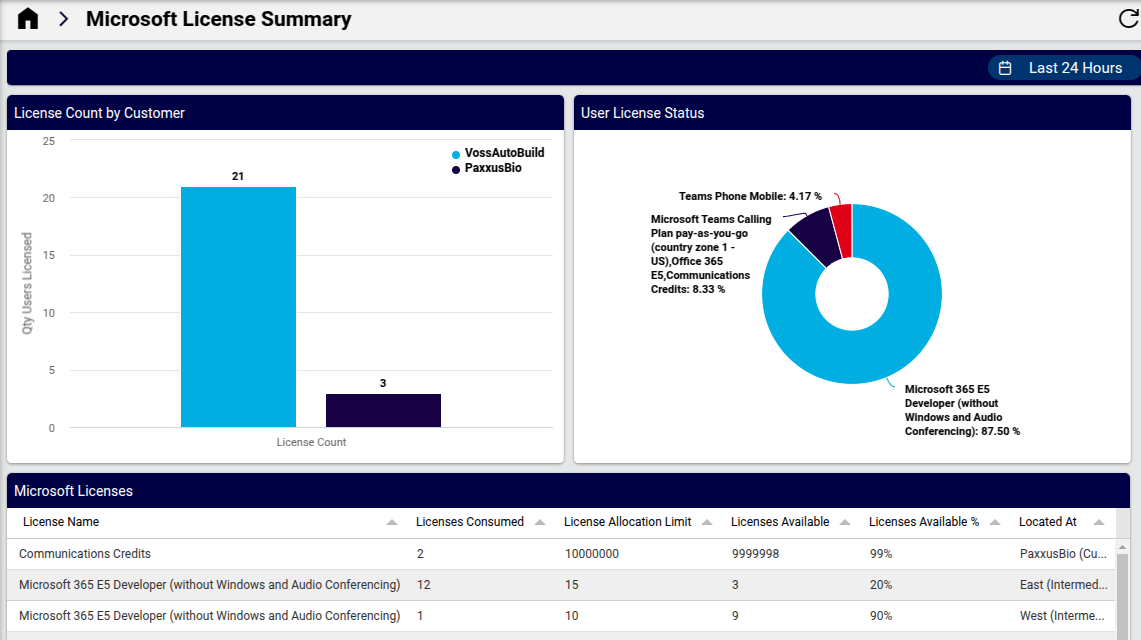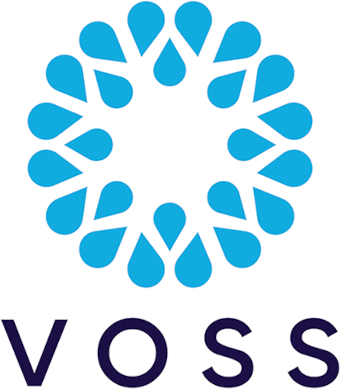Microsoft License Management and Alerting#
Overview#
Where Microsoft 365 user licenses are available to an organization as a whole on a single Microsoft tenant, VOSS Automate offers support for the allocation of these licenses to various business units and departments within such an organization - represented as hierarchies in VOSS Automate.
License allocation at a hierarchy can be managed in VOSS Automate from the Microsoft License Management group of the Microsoft dashboard.

In addition, a number of charts and tables are available to administrators on the Microsoft License Summary dashboards - providing an overview of license allocation, availability and usage at hierarchies. See: Microsoft License Summary dashboard.

VOSS Automate also enables you to set user license enforcement and allocation thresholds at hierarchies. This means that licenses will only be allocated to a subscriber at a hierarchy if these are available. Threshold availability percentage values can be set per hierarchy and allows for scheduled alerting to email groups whenever these thresholds are reached, so that timely action can be taken.
Related Topics
Prerequisites and first steps#
In order for the license enforcement, threshold percentage values and alerting to be available, it is necessary that:
Microsoft Licenses are available.
Licenses are synced from devices (device:
device/msgraph/MsolAccountSku) to the organization hierarchy level.The Microsoft Licenses link on the Microsoft License Management group of the Microsoft dashboard provides a list view of the global pool of licenses, showing active, consumed, available (incl. percentage) licenses per hierarchy.
License data syncs are configured. The feature provides:
Microsoft License Data Syncs
Microsoft License Model Type Lists
Microsoft License Schedules
offering default syncs and schedules that can be modified and used to manage license syncs at a hierarchy.
Note that:
An alerting schedule
MicrosoftLicenseAlertis also provided that can be further configured to schedule alerts if license alerting is enabled.Quick Import is enabled by default for syncs related to data/MSGraph that sync Microsoft license data from Microsoft Graph.
For details on data sync, refer to Introduction to Data Sync.
Global Settings need to be set:
Two settings are provided
Enable Microsoft User License Enforcement (default is No/Inherit):
If this setting is enabled, license allocations per hierarchy are enforced.
Microsoft License Alerting
If this setting is enabled, alerts are sent when configured license usage thresholds are reached at a hierarchy. See: Microsoft License Alerting.
Note that this setting requires that Enable Microsoft User License Enforcement is enabled.
See: Global settings.
Mappings for Microsoft License Names and Service Plan Names are noted.
On the the Microsoft License Management group on the Microsoft dashboard, VOSS Automate provides:
Microsoft License Names
A default mapping of License Number (SKU Part Number) to License Name
Service Plan Names
A default mapping of Service Plan Number to Service Plan Name
These mappings can be referenced and configured if required; and provide a user-friendly name display for these items on the VOSS Automate user interface.
Microsoft License Allocation#
Allocate licenses to a hierarchy.
Prerequisite: MS licenses have been synced in at high level organizational hierarchy.
Navigate to required hierarchy and open Microsoft License Allocation on the Microsoft License Management group on the Microsoft dashboard.
Add a new record to Microsoft License Allocation:
The License Name dropdown list only shows names of available licenses at the selected hierarchy (as mapped on the Microsoft License Names table on the Microsoft License Management group on the Microsoft dashboard). In other words, there is a single, unique allocation instance for a license name at a hierarchy.
A read-only number of the Maximum Limit Allowed is displayed for the selected license. This is the number of licenses un-allocated at or up the hierarchy.
Enter a License Allocation Limit number for the selected license name and hierarchy and save the record. If alerting thresholds are set for this limit, this number is used to determine the threshold value. If this limit is reached during subscriber licensing provisioning - for example using Quick subscriber (Microsoft) - the transaction will fail.
Note
When entering a license allocation limit at a hierarchy, the selected number may be less than the number of licenses currently consumed at the selected hierarchy - as reflected when viewing the added record. In this case, the new record requires modification in order to adjust this allocation limit.
The maximum License Allocation Limit for a specified hierarchy is obtained by the following calculation:
parent license allocation limit (the first instance found searching up the hierarchy) less the sum of (all license allocation limits set at the same hierarchy level)
If no parent license allocation limit exists, the total active units value is used, as sourced from the
device/msgraph/MsolSkuAccountmodel.
The added record displays in the Microsoft License Allocation list view, with columns showing:
The License Allocation Limit number as entered. (This number should not be higher than the Licenses Consumed.)
The current Licenses Consumed number as calculated for the hierarchy and lower.
The Licenses Available number and percentage (%) columns, as calculated for the hierarchy and lower.
The Located At hierarchy name.
In the global settings, select threshold percentages per license at a hierarchy using the Availability Threshold Percentage setting. If alerting has been enabled and the threshold is reached, an alert will be raised and also sent by email if enabled.
If alerting email groups have been selected in Global Settings, ensure that alerting Email Groups have been set up and selected as the global setting: Alert Email Group. (For details on how to set up email groups, see Email.)
Microsoft License Alerting#
On Global Settings, two settings need to be enabled to use the license altering feature:
Enable Microsoft User License Enforcement (default is No/Inherit):
Microsoft License Alerting
On Microsoft License Alerting:
Enable Alert on Microsoft Licenses (options: Yes, No, inherit. Default is No) Only if enabled, will any alerts be raised.
A license allocation transaction above a threshold of available licenses will fail and the alert will be created.
Fields are exposed to configure as below.
Availability Threshold Percentage (select from: 10%, 15%, 20%, 25%, inherit)
Set a percentage value of available licenses which, when reached, should trigger an alert.
Enable Email Group (choose: Yes, No, inherit)
An option to send the alerts to an email group.
Alert Email Group (choose an email group)
If enabled, the default email group to send alerts to - for email group setup, see: Email.
Note
If alerting is not enabled but user license enforcement is enabled, license transactions that result in exceeding available allocations will fail without a prior threshold alert warning.
Microsoft License Summary dashboard#
This dashboard provides default widgets that allow for the inspection of license usage:
Charts:
License Count by Customer
Provides a view of the number of licenses in use at the Customer hierarchy/hierarchies, at or below the current (customer/higher level) hierarchy.
User License Status
Provides a view of the percentage of licenses in use at the current hierarchy, grouped by license name.
Table:
Microsoft Licenses
Provides a detailed view of the licenses in use at or below the current hierarchy, with columns for:
License Name: the license name as mapped from the license SKU number
Licenses Consumed: number of licenses in use at the hierarchy
License Allocation Limit: license allocation limit (number) at the hierarchy
Licenses Available/%: number/percentage of licenses available at the hierarchy
Located At: hierarchy name
